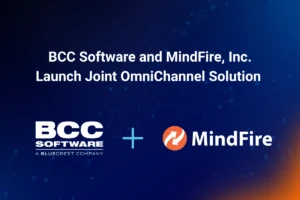Data is Key… Especially in an Election Year!
Table of Contents

As of this publishing, after 44 years in the print and mail Industry, with the last 15 at BCC Software, I will have retired. Consider this article as my swan song!
Since 1979, I’ve had the great pleasure of working with – and learning from – great companies in the subscription fulfillment, data processing, printing, software and hardware business of the print and mail market. They’ve afforded me opportunities and exposure to highly valued working relationships, which have enabled me to learn and grow.
My passion has always been around data and how it drives the processes well beyond just print and mail.
Data is key!
The more accurate it is, the better companies can manage and grow their businesses. Whether it’s identifying the characteristics of your best customers or using the data to identify your optimal prospects or markets, how companies consume and utilize data to drive their businesses varies dramatically.
Today, companies utilize business rules inside AI tools to aid in the standardization of how data is collected and stored. These same principles apply in marketing campaigns in the design, development, and channels used to target the best prospects or customers.
This same practice applies to elections. As reported in the 2020 edition of BCC Software’s eBook Guide to Election Mail, summarizing the 2018 election as a guide to the 2020 election, companies in the mailing industry experienced tremendous growth in election mail spending.
The research and studies show we can expect the same for the 2024 Election.
Therefore, delivering the message to correctly targeted voters residing in the state, district, precinct, city, or village for each of the candidates running is key.
Read the Updated Guide from BCC Software: Guide to Effective Election Mail
The 2024 election year is expected to be highly contested in many parts of the country. In their article, Politics and Digital Marketing in the 2024 Elections, The Goodway Group recently posted: “The 2024 political landscape is already shaping up to be just as contentious — if not more so — than that of 2020.”
And they also report: “The 2024 presidential election will likely be one of the most expensive races in American politics. Political ad spending is expected to reach $11 billion in 2024, according to a Vivvix analysis, making it one of the fastest-growing advertising sectors. Political campaigns will likely continue investing heavily in data analytics and machine learning to refine their targeting strategies. They will seek to deliver highly personalized messages to individual voters based on their demographics, interests and online behavior.”
Additionally, The Goodway Group also reports that local elections will be the biggest contributors to Political Ad spending.
A PEW Research Center article, Evaluations of members of Congress and the biggest problem with elected officials today, published on September 19, 2023, says: “Americans are more evenly split over whether campaigns have been interesting or dull, although they are still more negative than positive. About half (52%) say recent presidential campaigns have been dull, while 44% say they have been interesting.”
And “Among U.S. adults overall, 85% say elected officials do not care what people like them think. Just 14% say they do care.”
Therefore, the right message to the right constituents with the right message will be a key factor for voters in the 2024 election year.
Name and Address data is a primary driver in developing political campaigns.
While understanding the nuances of the data does drive the message, sending the appropriate candidate message to a person registered in the other party may miss the mark and end up in the trash — wasting all the efforts, effectiveness, and overall cost of the campaign.
Another factor is the voter registration data itself.
While registrars do a fantastic job managing the accuracy and completeness of their voter databases, voters do move. Looking for the change of address is important to not only keep voter rolls up to date, but also to know if they still reside in the location being targeted by the campaign.
Voter data, like subscriber or consumer data in other markets, can become stale, often unknown to a registrar.
Accurate data that adheres to the 3C Approach to Address Quality (Complete, Correct, and Current address information) ensures the right message hits the targeted voters with a Timely, Predictable, and Ultimate Delivery of a mail piece.
As BCC Software’s eBook “Guide to Election Mail,” reported, 86% of registered voters collect their mail at least 5x per week. Of those, 56% will immediately read their mail pieces. With many pieces likely arriving in the mail, it is critical that the mail moment experience convey the right message to the targeted voter.
Additionally, as showcased by a multitude of studies conducted by the USPS, as well as the Pew Research Center in their report The presidency and presidential politics, direct mail works for all constituents.
When asked to rank the three most credible political outreach techniques, 68% of those surveyed responded with mail sent to their home. Digging deeper into this statistic, the percentage of voting demographics that found mail among the most credible were suburban voters at 69%, female voters at 66%, non-white voters at 57%, and millennial voters at 56%. Direct mail continues to play a trusted and influential role during every phase of a campaign, from introduction to persuasion to voting decision for all kinds of voters.
68% of respondents indicated that mail sent to their home ranks among the top three most credible political outreach techniques when asked to evaluate various methods of engagement.
Heading into 2024, the demand for election print and mail will grow further with more and more candidates utilizing mail to deliver their message, beginning in the primaries, and extending on through the November general election. Preparing for this growth is a good time for companies handling election mail to look at their software automation.
Driving repetitive data processes using automation is an impactful time saver to accelerate the onboarding of new work.
As the research studies report, political ad spending will be one of the fastest growing advertising sectors in 2024. This will drive growth in mailing volumes, which correlates to more data processing, and ultimately more print for print and mail companies.
Successful companies who invest in automation and AI technologies will enable faster new client onboarding while maintaining effective, reliable, and repeatable processes that feed the core of their print and mail business.
Learn more about BCC Software’s full-service data management and campaign execution solutions.





